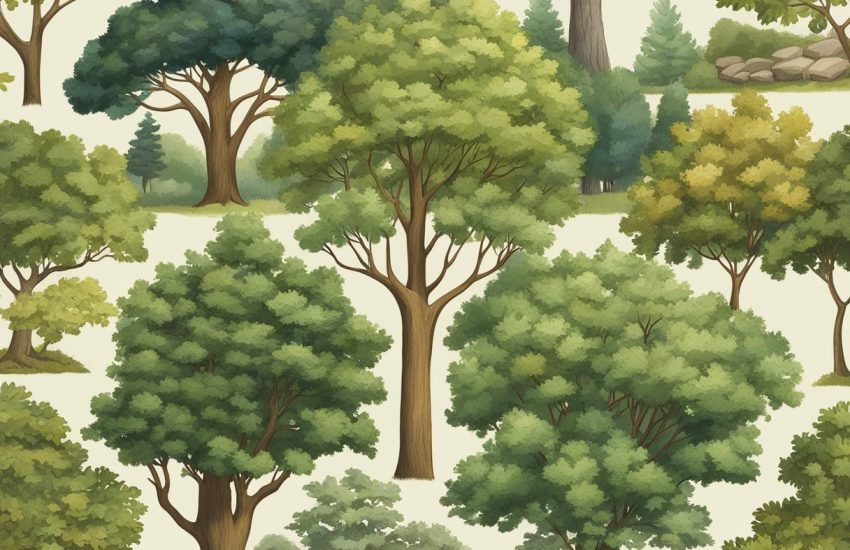15 Ornamental Trees to Grow in Southern California
Southern California is the region that stretches from the Sierra Nevada Mountains in the north to Tijuana in the South. The area expands down the Pacific coast. This region, which encompasses the Los Angeles and San Diego metropolitan areas, has a Mediterranean climate. It experiences wet winters, dry summers, and year-round warm temperatures. The area’s weather is accommodating towards all sorts of ornamental trees. Here are 20 species that thrive in the area!
Island Ceanothus (Ceanothus arboreus)
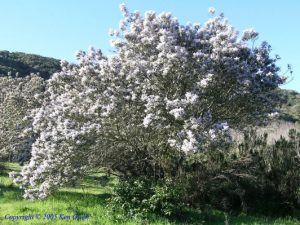
This incredible shrub is native to Southern California’s Channel Islands. Island ceanothus’s light purple racemes are beloved by local butterflies and quails. Its glossy foliage adds a welcome touch of texture and sheen to outdoor spaces. Its delicate flowers’ sweet smell fills the air in spring. This stunning tree does best in full sun and sandy soil. A typical island ceanothus will grow to be around 25 feet tall and 12 feet wide at maturity.
Mountain Ebony (Bauhinia variegata)
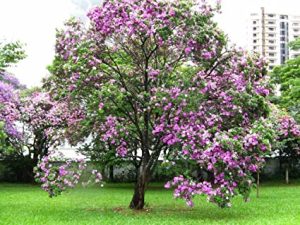
Mountain Ebony, or purple orchid tree, is a flowering evergreen that originates from China and India. It produces a widespread canopy of two-lobed leaves and pale pink flowers. Its conspicuous blooms give way to small seedpods in fall. This incredible plant can be propagated from cuttings or seeds. It’s a popular ornamental tree in Hawaii and Southern California. However, its ability to overshadow native species has some horticulturalists calling it invasive.
Eastern Redbud (Cercis canadensis)
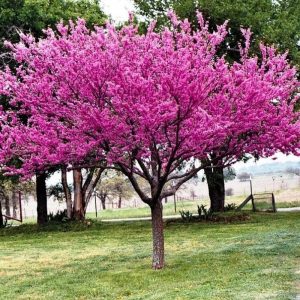
Eastern redbud, or Judah-tree, is a small ornamental tree that produces a showy display of flowers and foliage come springtime. The tree’s fuchsia blossoms cover its branches from top to bottom. The flowers precede the tree’s heart-shaped leaves. The blanket of all-consuming color serves to brighten up gardens and walkways. The pea-shaped flowers emerge in clusters along the tree’s otherwise naked branches. The fruits, which are long and bean-like, grow in the same fashion. The plant’s flowers tend to attract bees. The plant’s expansive crown is a welcoming habitat for birds and other small creatures.
Camphor Tree (Cinnamomum camphora)
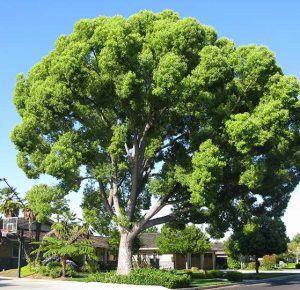
The camphor tree is a broad-leafed evergreen that offers ample shade. Its laurel-like leaves are used are sometimes used for medicinal purposes. Its yellow and white flowers bloom from April to May. The tree’s fissured bark gives it yet another layer of texture. This large ornamental tree grows with little effort. It does particularly well in Southern California’s dry, sandy soil.
Camphor trees are often propagated along streets in Southern California neighborhoods. These evergreens are also readily available at most California nurseries.
Silver Wattle (Acacia dealbata)
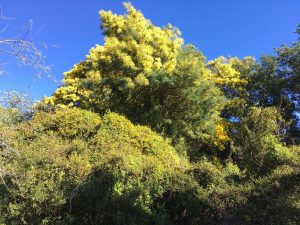
Silver wattle is an Australian acacia tree that grows well in Southern California’s coastal areas. It’s particularly prevalent throughout the San Fransico Bay area. The tree’s needle-like leaves grow from opposite ends of the tree’s branches. During spring and summer, the foliage grows alongside racemes of fuzzy yellow flowers. The tree’s flowers and foliage are popular additions to cut flower arrangements. This tree’s odd features and sweet fragrance make it a popular anchor for Southern Californian landscape borders and gardens. This stunning tree can even be propagated in a large container.
Silver wattle trees can grow up to 50 feet tall and 50 feet wide. They are short-lived specimens. Most do not live to be older than 50 years old.
California Flannelbush (Fremontodendron californicum)
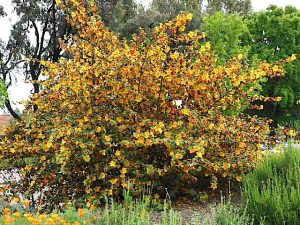
California flannelbush is a stunning evergreen tree. It’s native to the woodlands, canyons, and mountain regions of Southern and Central California. This spectacular plant yields lily-like flowers in spring. The yellow-orange blossoms are a huge draw for local birds and pollinators. The tree’s fuzzy leaves and twigs have a flannel-like texture. Each leaf boasts three rounded lobes.
This fast-growing species can tolerate Southern California’s hot, dry weather. Mature trees can reach heights of 20 feet. The tree’s rounded canopy can grow up to 20 feet wide in just a few short years. This native species is a perfect pick for first-time homeowners and inexperienced gardeners.
Olive (Olea europaea)
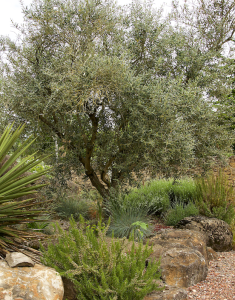
Olive trees are capable of producing an abundance of flavorful fruits. It does best in Southern California’s coastal regions. The olive tree’s foliage is thick, leathery, and green. It grows alongside small stem-like clusters of white flowers. Once the blossoms fade, the plant yields small green fruits. These can be cured or pressed into oil. Olive trees are incredibly resilient. Their knotted trunks add a welcome layer of texture to the lower part of hedges and borders.
These incredible plants are native to Europe. However, they’re a natural fit for Southern California’s Mediterranean weather. There are even a few low-yielding ornamental varieties, should you not want olives littering your lawn or garden.
Catalina Cherry (Prunus ilicifolia)
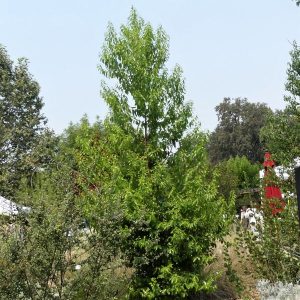
Catalina cherry is a flowering tree that thrives in Southern and Central California. This fast-growing plant can grow to be 30 feet tall and 20 feet wide. It produces an abundance of white and green flowers in late spring. The spiky blossoms typically appear in late April or early May. The tree’s leaves, which are shiny and green, remain on the tree’s branches all year long. The flowers precede the plant’s large black fruits. The berries are safe to eat. However, they’re typically left for the birds.
Catalina cherry originates from California’s Channel Islands. This splendid plant species grows to be rather tall and narrow. It’s a low-maintenance pick with very few special requirements.
Saskatoon Serviceberry (Amelanchier alnifolia)
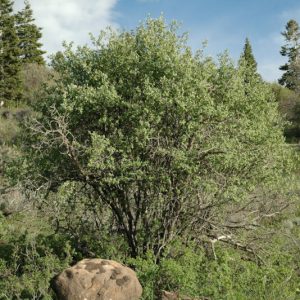
Saskatoon serviceberry is a small tree or shrub that grows well in Southern California. This lovely plant yields white flowers and blueberry-like fruits. The tart berries are a preferred food of Southern California’s native birds. They were also a staple food of Southern California’s native people.
The fragrant blossoms are accompanied by small leaves. The bright green foliage is small in size and oval in form. The leaves boast soft yet toothy outer edges and smooth surfaces. The tree’s dense, fragrant canopy is a welcoming home for native birds and other small creatures.
Saskatoon serviceberry trees do not usually grow bigger than 10 feet wide or 10 feet tall. They can be pruned so that they appear like small trees. However, they appear more like shrubs when they are left to grow freely.
California Buckeye (Aesculus californica)
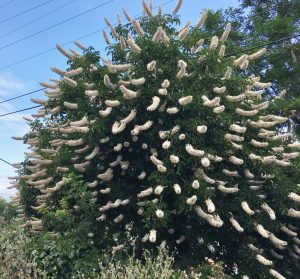
This stunning ornamental puts on an incredible show during all parts of the year. Its light gray park is often coated with lichens. It tends to have multiple trunks and a broad canopy. This ornamental tree produces an abundance of five-to-seven-piece leaflets. Its foliage is slender, green, glossy, and ribbed. Its pinkish-white flowers are arranged in large inflorescences at the ends of its branches. THe blossoms are incredibly fragrant. The flowers give way to sack-like nuts in fall. Unfortunately, the seeds are poisonous to humans.
This incredible tree grows wild in from Oregon to Southern California. The plant’s umbrella-like canopy can grow to be 30 feet in diameter. Yet, mature trees rarely exceed heights of 25 feet.
Yellow Bells (Tecoma stans)
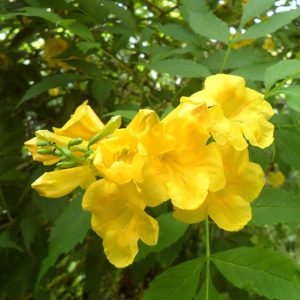
Tecoma stans is a fast-growing shrub that produces a particularly showy display of flowers. Its bright yellow blooms grow in clusters at the end of its grey-green branches. The trumpet-shaped blossoms sit alongside the tree’s olive-green leaves. Yellow bells can be pruned so that it looks like a tree. It will produce multiple trunks if it is not trimmed regularly.
This decorative plant does not usually grow taller than 6 feet. It’s a favorite of hummingbirds and other native pollinators.
Toyon (Heteromeles arbutifolia)
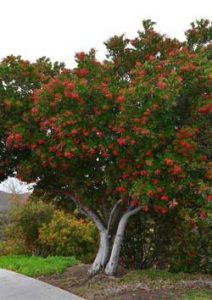
Toyon is another shrub-like tree that grows in the Sierra foothills and western California. These evergreen trees can grow to be 20 feet tall. Their serrated leaves are between 2 and 4 inches long. They boast prickly edges and a wax-like coating. They may be green or bronze depending on their age. Toyon berries are small and red. They are safe for consumption.
Toyon is often planted on slopes and hillsides. This drought-tolerant tree adds a welcome dose of color to Southern California gardens.
Western Redbud (Cercis occidentalis)
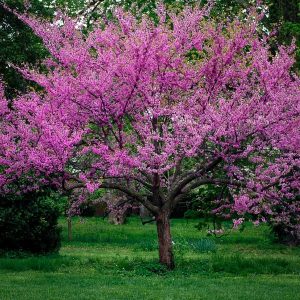
Western redbud is a small flowering tree that is found throughout the foothills and mountain regions of California. This incredible tree’s pea-shaped purple blooms last for several weeks. They preceded the plant’s blue-green leaves. They look magnificent against the redbud’s peeling bark and spindly branches. The fragrant blooms draw in all sorts of eager pollinators.
The western redbud can grow to be anywhere from 12 to 20 feet tall. Its canopy can be just as big or bigger! Its sweet blossoms are one of springtime’s most precious feats. This shrub-like species can be squeezed into just about any landscape.
Piute Cypress (Cupressus nevadensis)
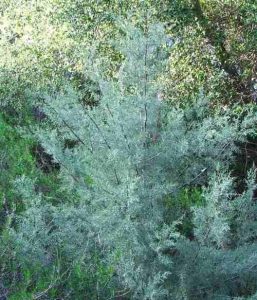
Hesperocyparis nevadensis, or Piute cypress, is an evergreen tree that is native to Southern Sierra Nevada. This petite plant produces a slender trunk and a conical canopy. It can grow to be 45 feet tall and just 2 feet in diameter. The gray-green foliage grows in clumps. It’s incredibly fragrant though very sparse. Small cone-like protrusions grow from the ends of the tree’s branches.
Piute cypress can live to be 200 years old. It’s a hard tree to start. However, you may consider propagating it from seed. It relies on wildfires for reproduction. Southern California’s wildfire impression tactics have led to a large dropoff in this tree’s local population.
Western Juniper (Juniperus occidentalis)
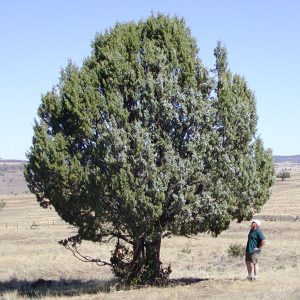
Western Juniper is a small tree that’s native to the western United States. This incredible species can grow to be anywhere from 15 to 50 feet tall. It tends to have a large trunk and wide-spread branches. The tree’s needle-shaped leaves appear on alternating sides of its twigs. The foliage is accompanied by fragrant berries. The pale blue fruits typically appear shriveled and dry. The tree’s shaggy bark is reddish-brown.
Western juniper trees can live to be 100 years old. You’ll need to take careful steps if you’re looking to incorporate this native tree into a landscape. Western juniper requires rocky soil, direct sunlight, and ample water.
Mexican Palo Verde (Parkinsonia aculeata)
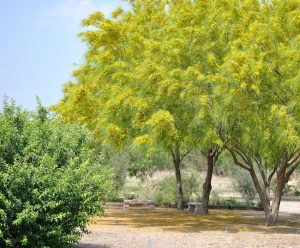
Mexican Palo Verde’s leaves and wood are highly regarded by native Mexicans. These mesmerizing trees make excellent privacy borders and shade providers. Their rounded crowns are adorned with arched branches. They yield an abundance of yellow-green leaves and orange and yellow flowers. The tree’s bark is bright green with distinctive brown markings.
These trees can grow to be 25 feet tall. Their rounded canopies typically stretch as wide as the trees are tall. They make excellent additions to yards and gardens. They are a perfect match for Southern California’s Mediterranean climate.
Honey Mesquite (Prosopis glandulosa)
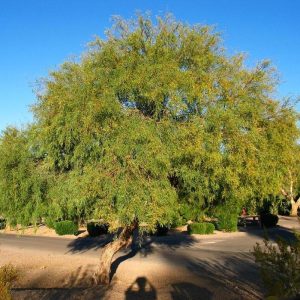
Honey mesquite is a small tree that comes from the Southwestern United States and northern Mexico. Its feathery leaves are accompanied by long, yellow beans and fragrant blossoms. Its asymmetrical crowns can grow from one or more trunks.
These desert trees offer shade and protection. Their ornamental qualities make them popular anchors for Southern Californian landscapes and gardens.
New Zealand Christmas Tree (Metrosideros excelsa)
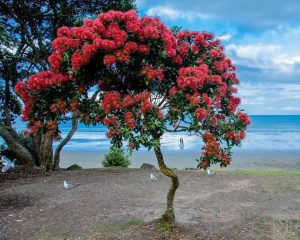
The New Zealand Christmas tree, or pohutukawa tree, is a perfect pick for a Southern California landscape. After all, Auckland and L.A. are approximately the same distance from the equator. This incredible plant is known for its ornamental properties. Its eucalyptus-like flowers and leathery leaves are perfectly suited for one another. The crimson blooms look like feathery puff balls. They typically stick around from May to July. They add a welcome pop of color to the tree’s arched canopy.
Screwbean Mesquite (Prosopis pubescens)
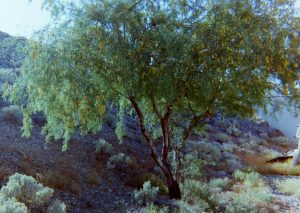
This intriguing tree is native to Southern California and northern Mexico. It prefers the fast-draining soil of desert washes and alluvial areas. Its unique foliage and mesmerizing fruits help to set it apart from other native trees. Its most noteworthy features are screw-like beans. These spindly pods grow in clusters at the ends of the tree’s branches. They’re accompanied by small, gray-green leaves and preceded by whitish-yellow flowers. The blossoms typically appear between May and July.
This plant has a unique history that dates back to ancient times. Its fruits were an integral part of native people’s diets.


